Xiaomi Mi 10T Pro review: the best value flagship of 2020
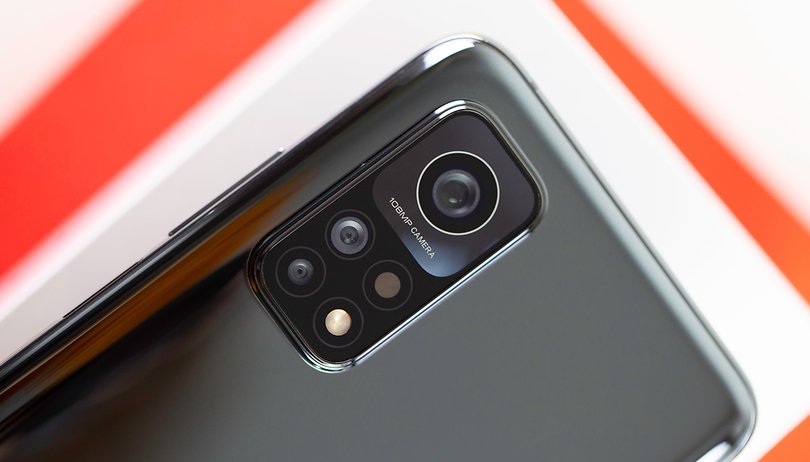

Mid-summer 2020, here is a vintage that will mark the smartphone market. The Xiaomi Mi 10T Pro is an excellent value for money flagship with a Snapdragon 865, a 144 Hz screen, 5,000 mAh battery for less than £550. In my full review for NextPit, I tell you why the Xiaomi Mi 10T Pro is the best value high-end smartphone on the market this year.
Good
- The 108 MP camera
- The smooth 144 Hz LCD screen
- The Snapdragon 865
- MIUI 12
- 5,000 mAh battery
Bad
- No dedicated telephoto lens
- No wireless charging
- Ads in MIUI
- No IP certification
- Non-expandable storage
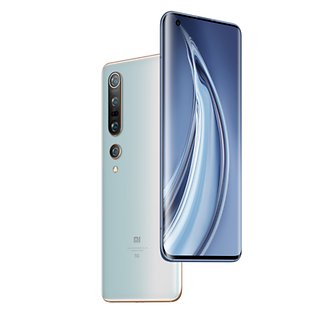
Who is the Xiaomi Mi 10T Pro for?
The Xiaomi MI 10T Pro is available today in two memory configurations. The 8GB/128GB version costs £545 while the 8GB/256GB model is sold for £599. The smartphone is available in three colours: Cosmic Black, Lunar Silver, and Aurora Blue. The latter is only available for the most expensive 8GB/256GB version.
As I mentioned in the introduction of this review, you'll find all the key points of an ultra-premium smartphone here. The Snapdragon 865 is more than welcome. The triple photo module with its big 108-megapixel sensor is already luring me. And the 5,000 mAh battery promises to handle the hefty energy needed to power this 144 Hz display.
On paper, the Xiaomi Mi 10T Pro is, therefore, better on price than the Mi 10 Pro and technically better than the Mi 9T Pro, which is still top of the smartphone comparisons in terms of price-to-performance ratio. But Xiaomi still delivers a nice slap in the face of OnePlus, as the OnePlus 8 is more expensive than the basic Mi 10T Pro. Of course, we're waiting for the OnePlus 8T but I doubt it will drop at under £600.
A neat but protruding design
As with almost every more or less high-end Xiaomi smartphone, the design of the Mi 10T Pro is very neat. Glass back, metallic edges and flat-screen discreetly pierced by a hole punch at the top left.
But what strikes you when you look at the Xiaomi Mi 10T Pro from the back is the size of the rear photo module. Not only is the large 108-megapixel main sensor staring at you like the Eye of Sauron, but the rectangular island in which the three lenses are placed stands out a lot.
It's a big photo module, or rather a thick one. When you lay the smartphone flat, it wobbles a lot. But it gives a rather particular look to the smartphone, almost humanizing. I know it's stupid and surely absurd, and I have an unfortunate tendency to like "ugly" smartphones like the Vivo X51. But, I fully understand that a Cyclops eye perched on the back of a smartphone can put off more than one customer.
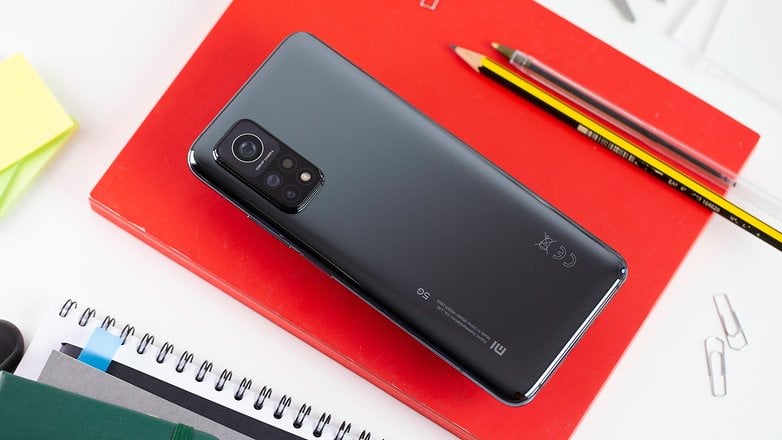
The smartphone is generally quite massive, but it has excellent grip. The screen, the display, may be flat, but the panel is still curved at the edges. The transverse edges are flattened, which has the effect of interrupting the "curved" movement of the rest of the design, a way of containing the curves of the smartphone like a corset. I have a hard time imagining it in writing, but it's a really nice detail.
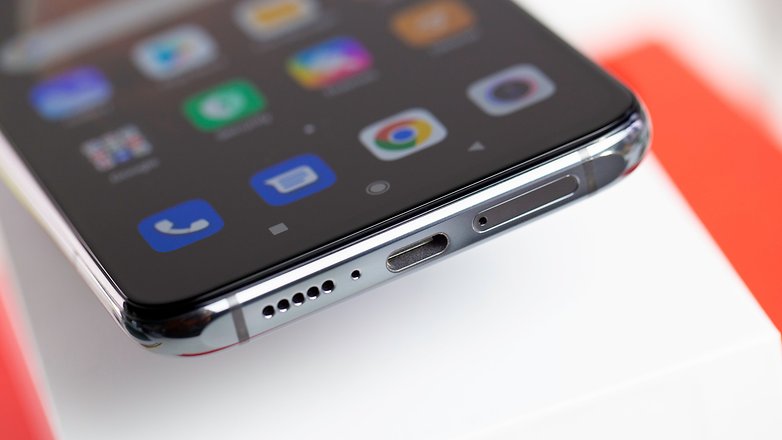
The unlock button, which also houses the fingerprint reader, is quite well placed on the right edge of the Xiaomi Mi 10T Pro. The lower edge houses the USB-C port as well as a speaker and the slot for SIM cards. There is no possibility to place a microSD card in here, as is now and sadly the standard in this price range. The Xiaomi Mi 10T Pro also doesn't have IP certification for waterproofing.
Overall, the design is not as polished as on the Xiaomi Mi 10 Pro but I find the smartphone has a certain cachet and I found it very pleasant to handle.
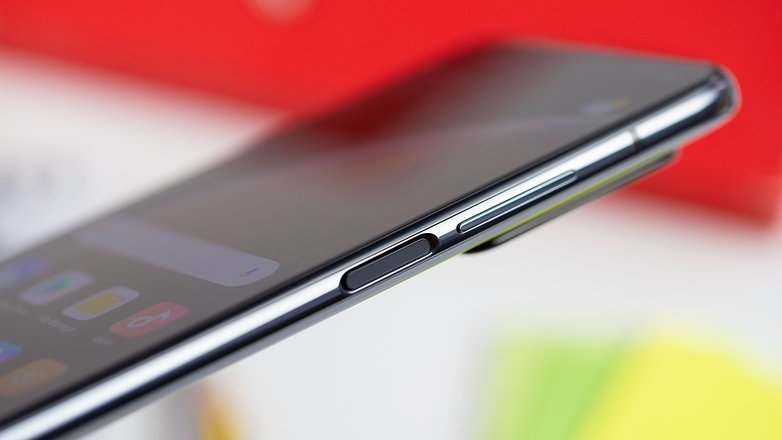
The LCD screen but in 144 Hz
Yes, an LCD screen hurts a bit on a flagship. But Xiaomi promises that "The Mi 10T Pro has one of the best LCD screens currently built into a smartphone".
And in use, I found the maximum brightness of 650 nits promised by the manufacturer very effective to ensure good readability in all circumstances. The contrast is a little less compared to that of an AMOLED panel and the reflectance rate is also more noticeable, naturally.
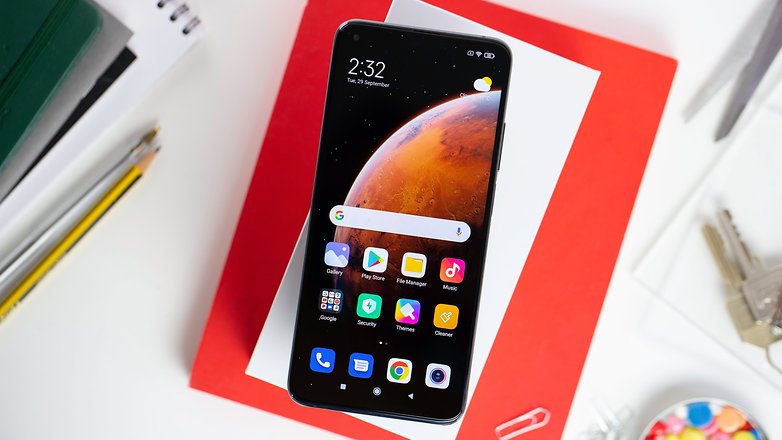
But to pass the pill, the Xiaomi MI 10T Pro offers a 6.67-inch panel with a refresh rate of 144 Hz. A feature that is currently only seen on gaming smartphones, for the most part. This refresh rate is obviously dynamic so it adapts to the use of the smartphone and the applications you open, switching between 60 and 144 Hz in order to preserve the battery.
To be honest, I have nothing against LCD screens. There are some really good ones on the market, and I prefer a 144Hz LCD than a 60Hz AMOLED. But that's a personal choice, I admit. Moreover, the refresh rate, endlessly marketed for gaming use, is not everything.
We must also talk about the touch sampling rate, that is to say, the number of times per second that the smartphone screen records a touch contact with your fingers. The higher this notion, also expressed in Hz, the more responsive the screen will be for touch controls.
On a high-end gaming smartphone like the Asus ROG Phone 3 for example, the touch sampling rate is 240 Hz. On the Mi 10T Pro, it is 180 Hz. And I can guarantee you that you can feel the difference in use in terms of sensitivity and tactile feedback.
But that's a nerdy concern that almost all consumers don't care about. Overall, the Xiaomi Mi 10T Pro's screen is very successful. I understand the choice of an LCD panel and I do not find it detrimental to the user experience thanks to the fluidity of the display.
MIUI 12: entertainment, security, and... ads
Much has been said about MIUI 12 . The hype around Xiaomi's new overlay was real when it was presented last May. I have devoted a complete review article to MIUI 12 which I invite you to read if you want a more complete opinion on the matter.
Visually, Xiaomi's Android overlay is a real UFO. But it is also very worked and optimized with great efforts made by the manufacturer on the protection of personal data, customization and ergonomics.
From the lock screen, MIUI 12 launches the credits and begins what looks like a real sequence shot movie in terms of feeling. Let's start with the "Super Wallpapers". It is a feature which consists in offering quite spectacular animated wallpapers.

You have the choice between three visuals, one of the Earth (Super Earth), one of Mars (Super Mars) and one of Saturn (Super Saturn). When you wake up the locked screen, the animation starts with a close-up of the planet seen from space. Once the screen is unlocked, an animation starts a progressive zoom on each planet as you arrive on the home screen of your Xiaomi smartphone.
For now, only a handful of smartphones offer this function and this was not the case with my Xiaomi Mi 10T Pro. But there is a fairly simple method (based on APK download and Google Wallpaper) that allows you to enjoy it on almost any Xiaomi smartphone. I made you a quick guide if you are interested.
In fact, it never stops, we have entertainment everywhere. When opening an app, instead of opening and closing from the middle, each app in MIUI 12 visually opens directly from the app icon and disappears behind when opening closing.
We also have animations in the battery utility, in the storage settings. Animations that can be customized, with different choices of icons, etc... I did not find that the battery was drained more than on smartphones with lighter interfaces, and the navigation system has always been very fluid. It is quite impressive.
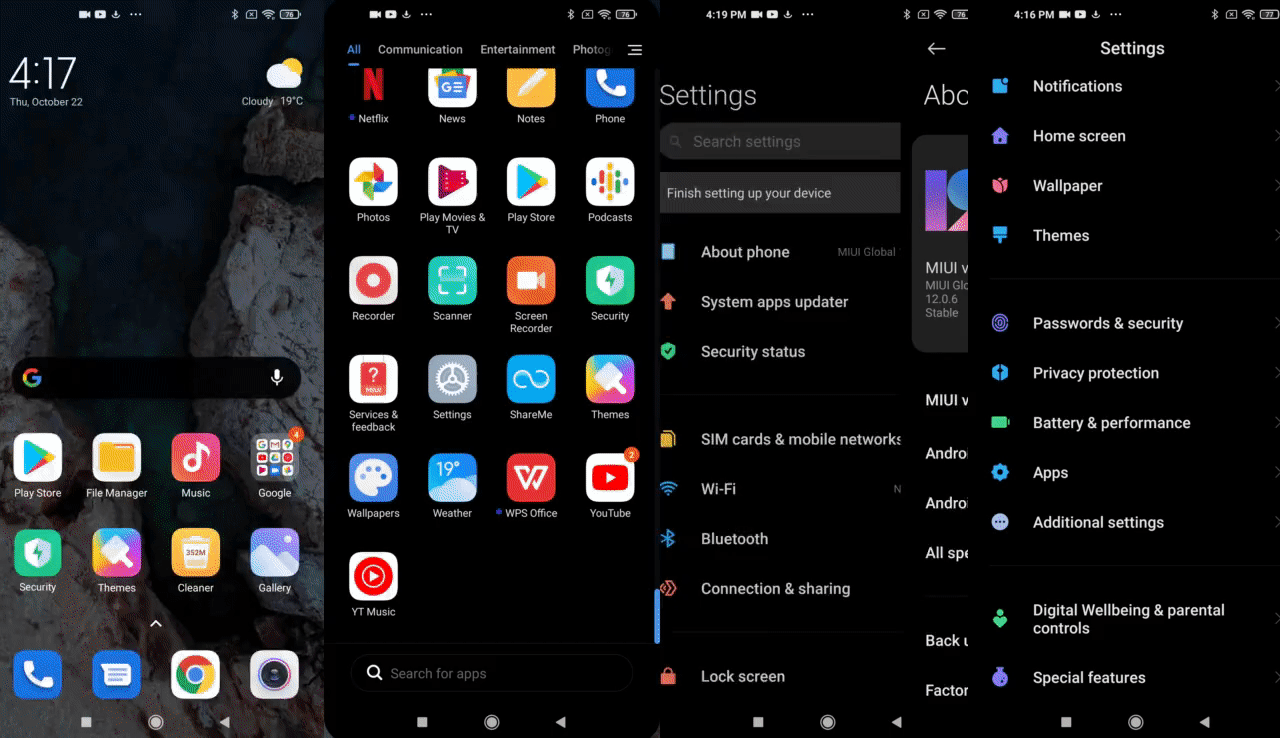
We are also entitled to the Mi Control Center, which is much more than an expanded drop-down notification menu. In fact, the top part of the screen in MIUI is split in half. Swiping down from the top left corner takes you to the notifications screen, nothing more.
To access the Mi Control Center, you must swipe on the upper right corner. It's a bit counter-intuitive at first but you get used to it stiffly. It, therefore, contains all the system application shortcuts, the native screen recorder, dark mode, etc ... as well as network and Bluetooth connectivity information.
And if everything is rather well done and customizable, I regret not having everything, the control centre and the notifications, in the same place. In any case, I find it a shame to have to perform two different gestures to access this information separately.
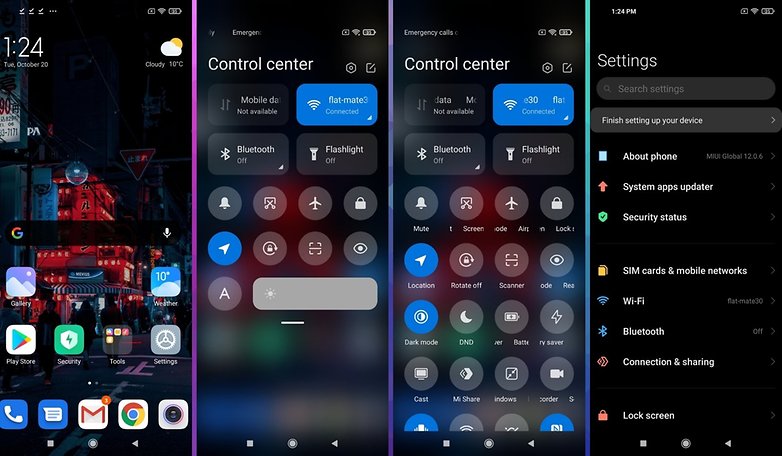
With MIUI 12, Xiaomi also places great emphasis on the protection of your personal data. The new interface embeds a management system for authorizations granted to applications. It's a complete overhaul of the permissions manager that allows you to quickly see which applications have which permissions.
You also have notifications, each time an application requests access to the camera, microphone, or location, which are displayed in large characters and take up nearly a third of the screen. When you launch a system app for the first time, MIUI 12 draws your attention to the information that the app will be able to access. This feature has been named "Barbed Wire" by Xiaomi.
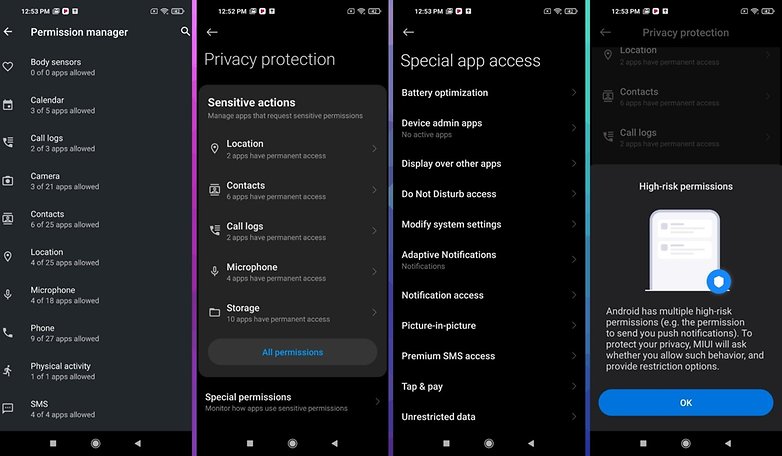
MIUI also sends you an alert whenever an app attempts to use the camera, microphone, or location without your permission. This feature also makes it possible to keep a log of each time an application uses a certain permission. You can see in real-time how and when an app accessed your data.
Finally, there is another feature called Mask System, which returns dummy or empty messages by default when a third-party app tries to access your call log or messages. This function is intended to prevent questionable applications from reading your private data.
Another strong point in terms of security and privacy is the possibility of creating a virtual ID. Concretely, MIUI 12 allows you to hide the personalization of the browser behind a virtual profile. You can reset this virtual ID whenever you prefer to clear any customization related to usage or preferences.
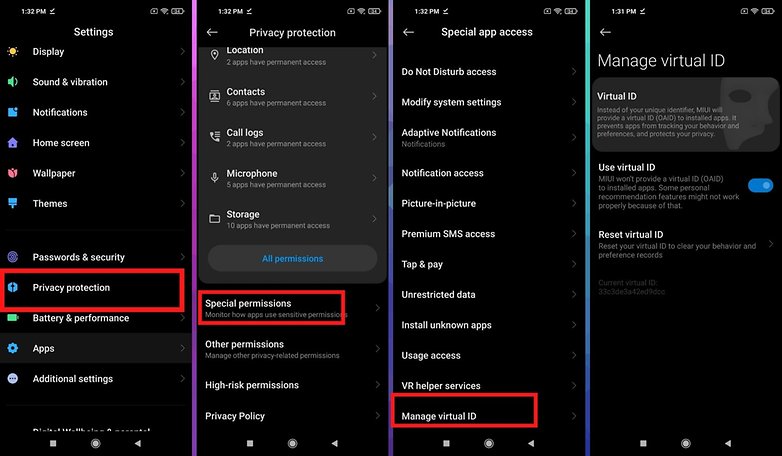
Finally, I must point out that I experienced advertisements at the start of my test at the system interface level and in some native applications. The Xiaomi Mi 10T Pro that I tested was under Global ROM, and I did experience a pop-up advertisement when setting up the smartphone, while trying to install dynamic wallpaper. So it was an ad in the native Xiaomi Themes app in MIUI 12. I have since written a fairly comprehensive guide to getting rid of ads in MIUI, and I haven't seen any more since, during all the rest of my test.
I could also tell you about the floating windows for multitasking, the app drawer, Mi Share or the new Focus Mode, but to save you a test that is already endless to read, I will simply redirect you to my full test of MIUI 12 linked at the top of this section.
Overall, with MIUI 12, Xiaomi has managed to convince and seduce the OxygenOS follower that I am. Although I prefer light interfaces, without being an Android Stock obsessive, I found the MIUI 12 overlay to be very busy but also very fluid and very visually pleasing.
It is one of the most atypical interfaces on the market but also the most polished.
The power of the Snapdragon 865
It is difficult (but not impossible) to find an Android smartphone with a Snapdragon 865 below the £600 mark. I'm starting to get tired of repeating myself in each test since we have almost all understood that this high-end SoC always offers very good performance.
The Xiaomi Mi 10T Pro performs very well on the 3DMark graphics benchmarks compared to the OnePlus 8T, equipped with the same SoC. Faced with high-end gaming smartphones like the ROG Phone 3 and the RedMagic 5S, with more RAM and with better temperature control, the scores are logically lower.
But in use, you can run the most resource-demanding games with the graphics pushed to the max without any problem. I didn't experience any browsing or multitasking issues.
Xiaomi Mi 10T Pro benchmark comparison:
| Xiaomi Mi 10T Pro | OnePlus 8T | RedMagic 5S | Asus ROG Phone 3 | |
|---|---|---|---|---|
| 3D Mark Sling Shot Extreme ES 3.1 | 7102 | 7112 | 7736 | 7724 |
| 3D Mark Sling Shot Vulkan | 6262 | 5982 | 7052 | 7079 |
| 3D Mark Sling Shot ES 3.0 | 8268 | 8820 | 9687 | 9833 |
| Geekbench 5 (Simple / Multi) | 908/3332 | 887/3113 | 902/3232 | 977 / 3324 |
| PassMark Memory | 28045 | 27766 | 27.442 | 28.568 |
| PassMark Disk | 94992 | 98574 | 88.322 | 124.077 |
I also ran the new 3DMark benchmarks called Wild Life and Wild Life Stress Test. These tests consist in simulating, for 1 minute for one and for 20 minutes for the other, an intense game session with the graphics pushed to the max.
The interest of these tests is that they inform us about the temperature control and the consistency of the FPS displayed on the screen during these simulation sessions. Basically, we have a theoretical overview of how the smartphone behaves when you launch Call of Duty Mobile with the graphics in ultra mode.
On an intense 20-minute session, the Xiaomi Mi 10T Pro maintained a framerate that oscillated between 16 and 43 FPS and a temperature of 32 to 38 ° C. The critical temperature of 39 ° C is therefore never exceeded and overheating remains fairly limited.
Xiaomi did not give details on its internal cooling system. In all cases, the processor and its Adreno 660 GPU coupled with 8 GB of LPDDR 5 RAM and UFS 3.1 storage allow good gaming performance.
A triple 108 MP photo module
On paper alone, the large 108-megapixel main sensor makes me want to test the smartphone on the spot. We remember the Xiaomi Mi Note 10 which was the first smartphone launched in Europe to embed a sensor with such a high resolution, ahead of the Samsung Galaxy S20 Ultra.
In short, on the back of the smartphone we find a triple photo module:
- A 108 MP main sensor with a size of 1 / 1.33 ”and an aperture of F / 1.69 with pixel binning (4 in 1 Super Pixel), an FOV of 82 ° and OIS (optical stabilization)
- A 13 MP ultra-wide-angle sensor with a size of 1 / 3.06 ”and an aperture of F / 2.4, an FOV of 123 °
- A 5 MP macro sensor with a size of 1/5 ”and an aperture of F / 2.4, an FOV of 82 ° and an autofocus (from 2 to 10 cm from the subject)
The selfie camera has a 20-megapixel sensor with a size of 1 / 3.4 ”and an aperture of F / 2.2 with an FOV of 77.7 ° and pixel binning technology.
On paper, the Xiaomi Mi 10T Pro has almost everything going for it. All that was missing was a dedicated telephoto lens to ensure the most versatile range possible, but which the manufacturer ignored.

The photos of the Xiaomi Mi 10T Pro by day
By default, the Xiaomi Mi 10T Pro captures shots at 27 MP (108 MP / 4) via pixel binning. But you can switch to Pro mode to take pictures at the full 108-megapixel definition, which allows for better exposure and more detail although the difference is really very subtle.
By day, even in less than optimal light conditions (thank you for the Berlin climate), the main sensor is doing very well. The sharpness is present and I was very satisfied with the level of detail captured. The exposure is well managed and the colourimetry natural.
In ultra-wide-angle, the quality deteriorates slightly. The photo remains clean but I could see a tendency to overexposure. Look at the top left image below, it is much brighter, overly lit, compared to the rest of the shots.

The photos of the Xiaomi Mi 10T Pro in zoom
The Xiaomi Mi 10T Pro skips a dedicated telephoto lens to ensure the most versatile photo range possible. We can therefore expect a digital magnification that will rely on the large resolution of the main sensor of 108 MP in order to cut and crop the image to apply the magnification.
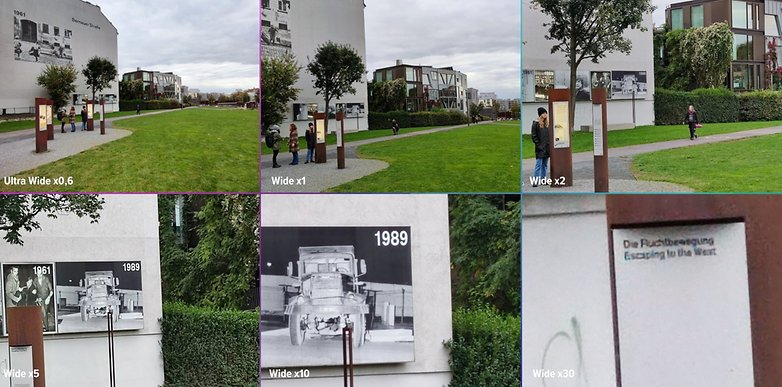
The maximum zoom you can apply is a x30 magnification. The latter is not usable and is, in any case, irrelevant for hand-held photos without a tripod. For the rest, from x2 to x10 magnification, I found the results significantly better than what I was able to achieve with the OnePlus 8T and its 48-megapixel sensor.
Then again you can see the uselessness of the x30 zoom without a tripod, the grain is everywhere and the pixel mush barely makes it possible to distinguish the German inscriptions on the panel. But I found that the x2 and x5 zooms were quite effective in limiting the loss of detail.
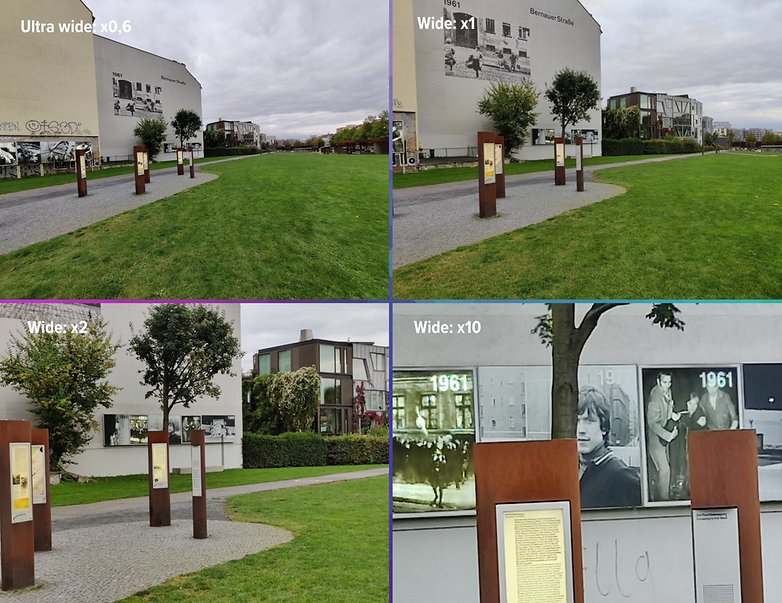
The photos of the Xiaomi Mi 10T Pro at night
At night, the 108-megapixel wide-angle sensor of the Xiaomi Mi 10T Pro does remarkably well, even better with the dedicated night mode. The latter allows the scene to be well lit without burning the photo by accentuating too much bright light sources such as urban lighting.
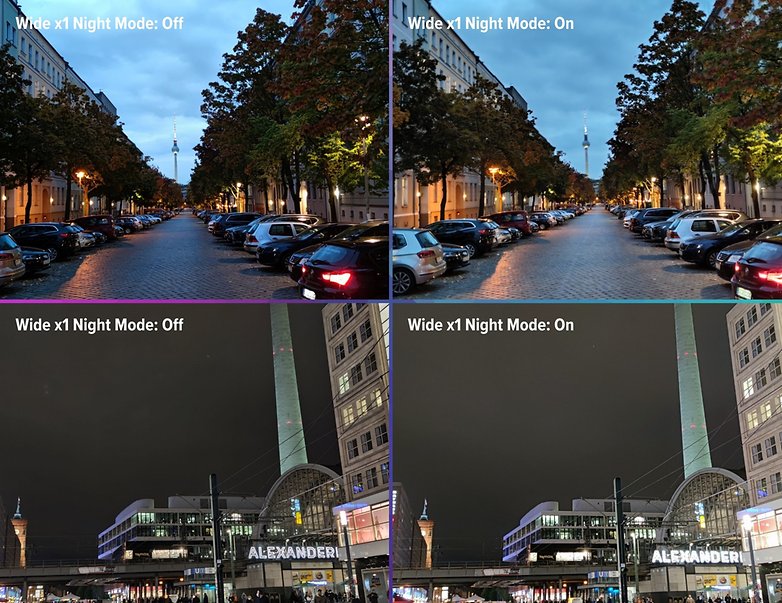
We can note a smoothing a little too pronounced to reduce digital noise, which makes the shots lose sharpness. The ultra-wide-angle lens is really bad in low light, but I found the zoom to be effective, especially in terms of the level of detail.

Overall, the Xiaomi Mi 10T Pro's photo module is perfectly consistent with the price of the smartphone. Day and night, the wide-angle shots are excellent. The zoom remains effective as long as it is limited to x2 or even x5 magnification at most. The ultra-wide-angle is too average for a smartphone that wants to be high-end, but the powerful night mode catches up with the photo module that I found more effective than that of the OnePlus 8T, sold at the same price.
But I can't help but think that a telephoto lens would have been better than a macro sensor, even if for once we don't end up with a macro with a ridiculous 2-megapixel but 5-megapixel resolution.
Spectacular battery life
The Xiaomi Mi 10T Pro is equipped with a 5,000 mAh battery . It is a large battery more than welcome to cash the energy costs involved in a screen with a high refresh rate.
For charging, the Xiaomi Mi 10T Pro is supplied with a 33 W charger (11V / 3A). Enough to allow it to recharge from 10 to 100% in just an hour. A very good result, especially considering the large battery of the Mi 10T Pro. Note, however, that the smartphone is not compatible with wireless charging.
During my test, I used the Xiaomi Mi 10T Pro with a dynamic refresh rate of 144 Hz (it goes to 60 Hz in the system interface, for example, then 144 Hz when in-game) as well as with the adaptive brightness. All in all, I held on average more than 20 hours before going under the 20% remaining autonomy. TWENTY HOURS! And that, with over six hours of screen time spent on mobile games, video calls and video streaming.
I tell myself that with the screen locked at 60 Hz and less intensive use, with say a screen time of three hours, the battery life must exceed the two full days of use. This is a real tour de force for Xiaomi and a lesson in optimization for its competitors.
Even with the PCMark benchmark that we use for the battery at NextPit, and which simulates an unrealistic use because too intense of the smartphone, the Xiaomi Mi 10T Pro held 23 hours before falling below the 20% remaining battery level.
I know some Samsung smartphones and iPhones that should kindly sit down, religiously take notes and review their copy because Xiaomi is hands down the top of the class at this price point.
Final verdict
The Xiaomi Mi 10T Pro is one of the smartphones, together with the Poco F2 Pro, the OnePlus 8T or the Oppo Reno 4 which form a new intermediate-range of "affordable" flagships. We have almost everything of a premium technical sheet without having to pay more than £1,000.
The 108-megapixel triple photo module is very good except at ultra-wide-angle, the Snapdragon 865 offers solid performance, the 144Hz LCD screen is super smooth and the 5,000mAh battery is nothing short of spectacular. Rarely have I used so many superlatives in a review, and if you read me regularly, you know how "sucker" I can be in my reviews.
But in terms of value for money for a flagship, we can hardly do better. I still have a preference for the OnePlus 8T, but it's really my (fully assumed) bias that makes me say that, just like my affection for OxygenOS 11.
When we know that the Xiaomi Mi 9T Pro, its predecessor, was the champion of the quality/price ratio and that it is still in 2020 at the top of the basket of reviews and other buying guides, we can say that the Xiaomi Mi 10T Pro is a worthy representative of his lineage.
If I had to recommend a flagship in 2020, and I had to disregard my bias for OnePlus, the Xiaomi Mi 10T Pro is undoubtedly one of the best choices if you want value for your money.
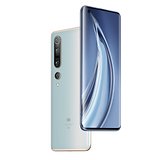


















I've got the mi 10t pro 8gb am and 256gb storage and I can truly say I'm impressed and love it. And you get so much for the price. I would recommend to anyone.
It is a good mobilephone
Redimi is good option and it have variable prices according to budget.
-
Admin
Nov 17, 2020 Link to commentI am a fan of Xiaomi and Redmi but, for what it offers, this one seems overpriced
Another terribly bloated skin you can't root away from. Not worth it.